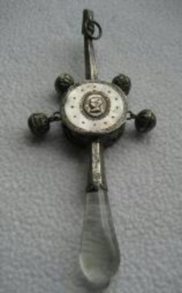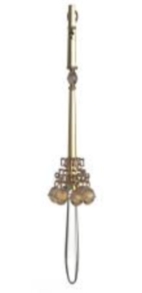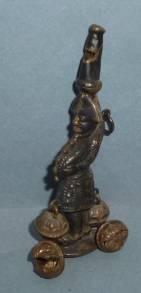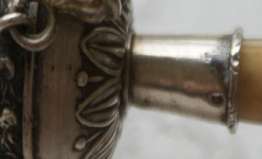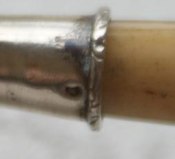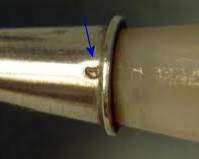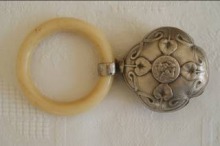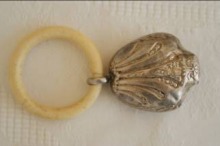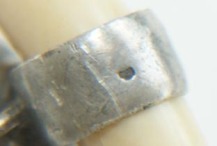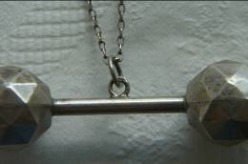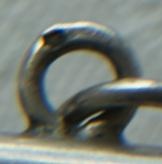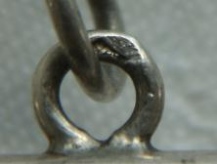by
Katherine Palthey
(click on photos to enlarge image)
FRENCH ANTIQUE SILVER RATTLES
Short history and how to identify them
Baby rattles "hochet" are among the oldest toys known in
France, and probably even in the world. Evidence of baby toys in
the form of rings, balls and sticks have been known as far back
as the roman times. In the northern part of Normandy,
archaeologists were digging up an antique cemetery in Evreux and
discovered what they described as a Gallo-Roman object very
similar to today’s baby rattle!
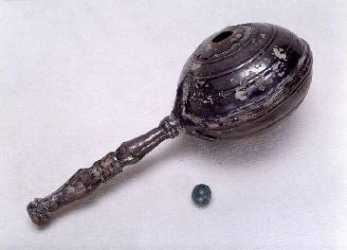
|
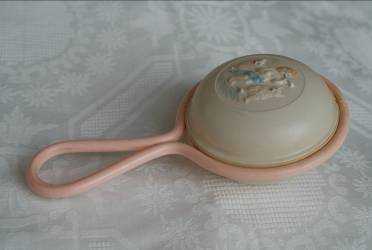
|
No Inv: 7226, Gallo-Roman
baby rattle
Musée de l'Ancien Evêché, Evreux
|
French baby rattle,
c.1940,
Lucite (transparent thermoplastic)
|
This important discovery in 1938 was one of many as more and
more excavations are enthusiastically financed in France. This
particular rattle pictured here is 20 cm long, with a silver
coated bronze handle, two sided holes bordered in silver with a
flattened sphere form, decorated with circular lines. Inside are
two ceramic beads, and it is still in working order!
Tracing back to the early medieval times, French historians
only had information on these baby rattles through writings,
stories and descriptions. By the 13th century the word rattle ("hochet")
was being used for the first time. Entering into the 14th
century, the rattle was being seen in paintings and drawings. At
this time in France, rattles resembled small shoes, horse sticks,
tops and balls. Traditionally, there has always been belief
about rattles with the "grelot" (little bell) inside. Priests
and dancers in certain cultures used these rattles either
hanging off their neck or tied to their ankles. The rattle noise
in their sacred dances were said to protect them from dangers.
These were worn like jewellery, so have been considered
religious jewellery as these traditional beliefs continued.
Rattles at this time were primarily made by "patenostriers"
whose main business included the making of rosary beads and
other religious artefacts. It was in the 15th century that the
rattle, started being made with other materials such as bone,
coral and shells, and took on a more "magical" meaning. The
middle age rattles had boar or wolf teeth attached to them as it
was thought to chase away evil spirits, and ultimately protect
children from sickness and even death.
In the French royal
archives dating back to the 1600's we can see the
beginning of some important examples of more
elegantly designed and engraved rattles being
ordered as well as being repaired. The royal
documentation records show that only the highest
quality materials were employed such as silver, gold,
coral, crystal and ivory. At this time, these
outlandish birth gifts represented power and
protective strengths among noble and bourgeois
families. Most rattle designs starting at this time
had long coral, crystal or ivory handles, and
several outside bells decorating a central sphere.
This was usually attached on a long chain for the
nurse to hang around her neck while entertaining the
child. Coral, throughout France, was believed to
protect and heal, as seen throughout French history
in holy paintings with both the Madonna and child
carrying coral necklaces.
(on the right) Madonna and Child from the
Isenheim Altarpiece, which was originally painted
around 1520 for a church in Alsace, attributed to
Matthias Grünewald
|
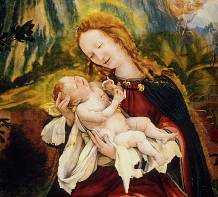
|
In ancient times, coral was considered a magic stone.
According to Ovid (Metamorphoses, IV, 740-752) red coral came
from Medusa's blood when Perseus beheaded her. When blood
entered in contact with air and sea, it turned the seaweed into
coral. The Romans believed that it could protect men from harm.
For Christians, instead, coral was Christ's blood and it was
considered a powerful amulet against demons and bad luck. Red
coral "corallium species" is found off the southern coast of
France in the Mediterranean, and from 15th to 18th century the
city of Trapani in Italy became the largest fishing and
manufacturer site of red coral in Europe.
In 1725, French statutes changed and divided the artisans into
different areas of specialties. Having only two "patenostriers"
left, these artisans integrated with the other craftsmen using
their specified material. For instance, after this time period
in France there were specific ivory, bone and mother of pearl
carving groups. Goldsmiths were now exclusively responsible for
objects made in gold as well as silver (silver was rare, because
it had been requisitioned by the Kings several times to be
melted down for war investments especially in 1689 with 20 tons
of furniture in silver alone!). After this time, all silver
rattles were made by established goldsmiths, whom in some cases
had already been placing their makers mark on their objects for
years. Inventory documents prove that it was Thomas Germain,
(1673-1748, and then his son François 1726-1791) who supplied
the royal court with silver smalls including baby rattles at the
birth of each prince and princess. It was at this period,
between 1720 and 1740 that silver gilding ("vermeil") became
very popular as seen throughout the royal palaces in France.
The next example shows how elaborate rattles were becoming with
8 hanging bells molded and engraved in silver with a coral
handle and on the far end in some cases a whistle incorporated.
Starting at this time we note two major shapes of rattles:
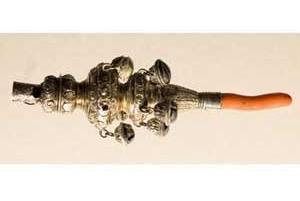
|
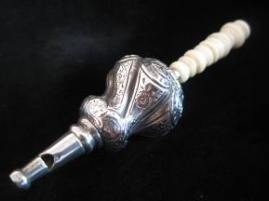
|
Red Coral and sterling
Rattle, long handle
with outside bells, 17th Century,
France Etude Sedde Dijon, 12/6/2006
|
Silver and ivory rattle,
long handle
with inside balls, 19th century,
Jacob Norden Fine Antiques, Belgium
|
European styles strongly influenced the designs of the
French silver rattle starting since the 17th century. At that
time, silver production was beginning to expand from Germany's
silver mine Rammelsberg (near Goslar in the Harz Mountains of
eastern Germany) and from the main European ports, facilitating
the diffusion of precious metal decorative items among
wealthiest people. In addition, being central to the European
trading ports, France benefited of the influences both English
and Italian. The advanced baby rattles designs manufactured in
these countries, coupled with the talent of Thomas Germains, set
a lavish baby gift trend throughout the noble families in
France. An increase in the demand of silver table items, silver
furnishings and silver objects was witnessed at the same time
especially in Paris and Versailles where Louis XIV was
decorating his opulent Chateau! Symmetrical scrolling, leaves,
faces, flowers and shell designs were popular at this time, and
often the French royal family and court's members possessed
gilded silver and even solid gold rattles, examples of which can
still be seen in several French museums today. The influences of
Italy's baroque decoration continued in France until the end of
the 18th century.
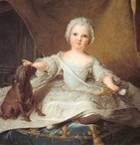
|
On the left: This
1751 oil painting by Jean Marc Nattier shows Marie
Zyphirine
of France (daughter of Louis XVI) with her sumptuous
(silver-gilt or solid gold)
rattle with coral handle and outside bells.
Uffizi Museum, Florence
|
It was only after the French revolution that the rattle
design became simpler, materials less expensive and more
affordable for other families. More original in form, we see the
neoclassical decorations typical of this time (especially after
the discovery of Pompeii) such as Egyptian motifs, symmetrical
sides, simple ribboning and musical themes. Also at this time in
France, we register the appearance of theatrical figurines such
as Harlequins, Marionettes and the famous French "Polichinelles".
Below, the first one on the left is a rattle given to the King
of Rome by his parents Emperor Napoleon I and Empress Marie
Louise in 1811. It has the form of a drum with four bells and is
engraved: "Roi de Rome" (King of Rome). It was sold for 5500
Euros on June 24th 2012 in Pamier France.
The second and third rattle show typical shapes and classic
styles in vogue in mid 19th century.
Until the mid of the 19th century France produced only small
quantities of silver, not sufficient to satisfy the demand.
Between 1856 and 1861 silver production attained record levels
reaching over 7,000,000 ounces of silver – almost 5% of the
world's total! After 1880 however, levels shrunk back down
reaching on average a quarter million ounces a year.
Silverplate copies of older rattles and rattles with fake
hallmarks started entering the market as prices of silver
climbed higher. This element and their popularity as collectors'
items makes identification even more complicated.
From late 19th century most of the French rattles were machine
produced and the use of hand rings was introduced into the
design using imitation ivory "French ivory" (including Bakelite
and plastics).
SILVER HALLMARKS ON FRENCH BABY RATTLES
The French hallmarking system is widely illustrated on ASCAS
website. Some examples of articles about this subject matter are
available following these links:
Silver Hallmarks of Paris (1723-1774) by Christophe Ginter
The Bigorne mark on French silver by Robert Massart
The triple master silversmith mark on French silver artifacts
by Lise Moor
For other articles about this matter (many written by Christophe
Ginter) see the
Site Map .
Further hallmarks are available also in Giorgio Busetto website
at
Hallmarks of French silver (from 1797 to present days) and
French Silver Hallmarks: Ancien Regime (18th century)
In this page I add only some information about hallmarks found
on silver baby rattles.
Most of the 17th century rattles produced by "patenostriers" are
unmarked and only few of the early French rattles produced by
established goldsmiths comply with the rules of the hallmarking
system. Only after 1725 goldsmiths became exclusive makers of
silver and gold items and proper hallmarks can be found on
silver rattles. In most cases, unless the piece was never really
used to sooth baby's teething urges, these marks are faint or
rubbed and often very difficult to decipher.
Moreover not more of two, of the series of four hallmarks
(maker, charge, discharge, "maison commune"), is actually
present on the rattles.
Rattles were hallmarked
along the mouthpiece or, if wide enough, near the
attachment, where the handle (either in coral, nacre
or ivory) was inserted on the silver body. If the
rattle had a hanging chain, each individual ring was
required to be individually hallmarked if possible.
According to the size of the object, smaller makers
mark could be used and charge/discharge marks
replaced the letters with tiny symbols (faces, heads
of animals, etc.). Note that this type of charge/discharge
marks is very small and often can be unnoticed.
On the right: a small maker's mark on the
mouthpiece of a baby rattle
|
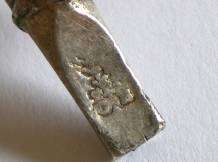
|
After the French Revolution (1789) the hallmarking system
was modified using three marks (maker, guarantee and fineness)
from 1797 and two mark (maker and fineness) after 1838.
Each silver item had a required location for the stamping of the
mark. On baby rattles the location is on the edge of the silver
handle or on the ring attaching the silver rattle to either the
ivory ring or chain.
Below are three examples of location of
boar head mark (800/1000 silver fineness for items made in
Paris) on baby rattle handle.
The following photos below show two different French rattles
produced at the turn of the century. The design is typical of
the Art Nouveau period with flowers and flow moving design. The
rings are real elephant ivory. They are hallmarked with boar
head and maker's mark lozenge on the hanging ring
This silver 1900s dumbbell rattle is hallmarked on both
sides of the hanging ring with boars head (center photo) and
with the "bigorne"(authenticity
countermark: photo on the right).
On the right are
illustrated four examples of French Art Deco Rattles,
quite popular from 1920’s to 1940’s.
They are properly hallmarked on the hanging ring,
with "bigorne" countermarks. The design is much more
geometric than the earlier years, with symmetry and
bold lines defining the areas.
The hand rings were more often made with synthetic
materials like Bakelite, plastics and Lucite.
Three have boars head hallmarks and the last one has
a "crab"
(800/1000 silver fineness in a Department outside
Paris).
The little rattle on the far left was made for a
doll (exists also a smaller size made for dollhouses).
|
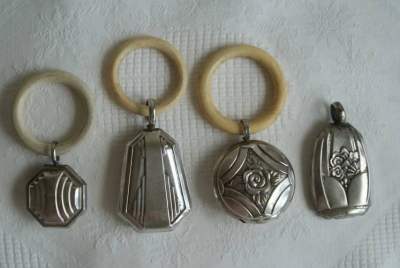
|
After the introduction of electrolytic process (second half
of the 19th century) silver plate rattles began to be
manufactured in France. Silver plate items can be distinguished
from that in solid silver by the shape of the maker's mark (a
square instead of a
lozenge).
Katherine Palthey
- 2013 -
|
|
|








